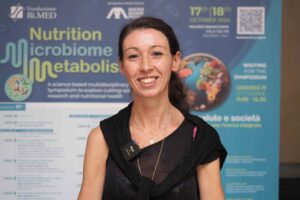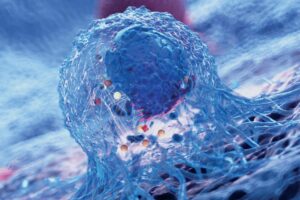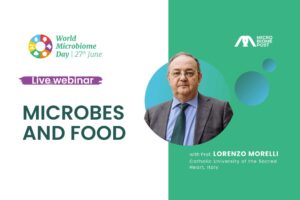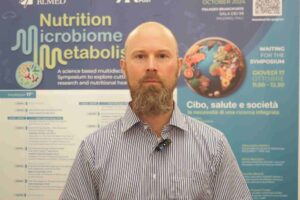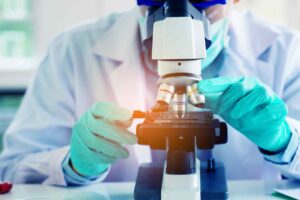One Health is an integrated and unified approach that recognizes that human health, animal health and ecosystem health are all connected. The microbiome is a key piece in the One Health puzzle given that microbes and antimicrobial resistance genes travel extensively between the different compartments, and effectively connects all healths.
So this year, the International Human Microbiome Consortium congress (IHMC) that took place in Rome end of June organized several sessions dedicated to the One Health approach. Being very interested in the role of the microbiome in One Health I followed all possible talks on this topic during the event last month, and share here key messages from the different experts.
1st Session The Interaction of the Human Holobiont With Other Bionts
Food safety scientist Stefano Morabito offered an outlook of One Health beyond the beaten tracks of human and animal health, aiming for a more circular bioeconomy in agriculture.
“The soil microbiome is the living ground-atmosphere interface”
Stefano Morabito
Climate change and increase in food demand put strong pressure on an exhausted system. Agricultural waste streams (slurry, manure, sludge, composte and digestates) can return nutrients to the soil, but also pass along pathogens and antimicrobial resistance genes from livestock. Some organic inputs like sawdust can improve the soil microbiome, and this represents a key towards restoration, but can’t be extrapolated to other organic inputs. Morabito asks how animal breeding could be changed to make for safer wastes. He refers to further studies showing that anthropogenic pressures perturbate the soil microbiome communities and concludes that more research is needed to inform policy-makers.
“Anything you add on the soil has an impact on the microbiome”
Stefano Morabito
Antonia Ricci, director of the Istituto Zooprofilattico Sperimentale delle Venezie, reviewed the role of the microbiome in a One Health perspective. “No microbiome is an island” and “we’ve been wearing blinders” she starts. We all agree on the theory of all healths being one, of the paradigm change that sees problems in the environment as a direct impediment on our health, but how do we practically pass to this approach? How do we monitor contaminants, pathogens, antimicrobial resistance genes, and control them? She gave the example of microplastics that not only damage soils but also provide habitat for pathobionts such as Vibrio species, which are also producers of the toxic molecule Tetrodoxin. With climate change and the growing microplastics pressure, setting limits for Tetrodoxin in shellfish may be needed, and depends on the shellfish microbiome.
“No microbiome is an island”
Anthony Amend and Elizabeth Pennisi
Microbiome ecosystems connect the environment, animals, foods and humans and are influenced by pollution, temperature, pH and anthropogenic factors.
Agricultural microbiology researcher Claudia Cortimiglia focused on food stressors and their impacts on the gut microbiome. Foods bearing the highest risk of antimicrobial resistance are meat, fermented milk and vegetables including ready-to-eat salad and fast-food.
Professor of microbiology and co-author of I microbi salveranno il mondo Duccio Cavalieri proposed an evolutionary perspective of the human microbiome. «Microbes maketh Man» as shows an Economist cover, and urbanization has maketh for another type of holobiont, poorer in Prevotella, richer in Bacteroides. Metabolomics reveal the urban microbiome is shifted towards protein metabolism and inflammatory pathways, giving hints in what went awry in our diets and habits.
Spanish researcher Ana Lopez Moreno revealed plastics exposure’s impact on the gut microbiota and childhood obesity. Bisphenol A, present on many plastic surfaces, has a negative impact on the gut microbiota composition and diversity, and associates with a higher Body Mass Index and obesity risk. Again, there can be no human health without nurturing the environment and controling pollutants.
Federica Carraturo, professor of public health, epidemiology and hygiene at the university of Naples, applied omics technologies to the thermal waters of Ischia, known for ages for their benefits when drunk or bathed into. These waters contain bacteria, fungi and algae and their metabolites, and the study of their metabolome and proteome can shed light on the extraordinary waters’ mechanisms of action.
“Microbes are the one thing we need to focus on in relation to human and planetary health. Instead of speaking of a One Health Approach we should almost speak of a Microbe Approach“
Federica concluded quoting Hellas Cena
In the panel discussion, the researchers spoke about the emergence of new vectors of diseases like insects, mosquitoes or blue crabs, a disaster for fish producers. We need to monitor and control these new pressures and take them in consideration as the world changes.
2nd Session The Interaction of the Human Holobiont With Other Bionts
Curtis Huttenhower, co-director of the Harvard Chan Microbiome in public health center in Boston discussed high-throughput discovery of microbial biochemical mechanisms, diving into the dark matter of uncharacterized proteins, including in the gut microbiome. “70% of protein families are uncharacterized” he said. His group uses machine learning to predict the functions of uncharacterized genes in the microbiome, aiming for novel bioactives discovery.
Frederic Bushman shone light on the forgotten members of the gut microbiome: the mycobiome, virome, archaeome and parasitome, and showed the different groups contribute to each other (especially to the virome).
Professor of health sciences Paola Roncada worked on the direct impacts of other microbiomes on the human microbiome. She studies metaproteomics of different foods as bioindicators of circulating antimicrobial resistome, and turns to honeybees as among the best indicators of One Health, she says. And the bees’ microbiome is key to their health and survival.
Lorenza Putignani, head of parasitology and human microbiome in the hospital Bambino Gesù in Rome, focused on health in relation to antimicrobial resistance and emerging pathogens. Her research group identified vertebrates and buildings as the places with highest abundance of shared resistomes, delivering critical pathogens. The researchers built huge databases, which now need to be fed into diagnostics to stop resistomes from spreading – requiring guidelines and training for gut microbiota testing interpretation. She also advocates to move from the microbiome to a broader idea of biome, and from identification to functional complexity.
Victoria Weinberger from Australia highlighted important Archae in the gut microbiome and their Archeal Extracellular Vesicles, and Hein Tun from Hong Kong worked on the gut-brain axis and a study of multi-omics revealing the involvement of the gut microbiome in depression through the disruption of the immune system and neurotransmitters.
Session Environmental Factors Influencing the Human Holobiont
Birgit Wassemann from Austria presented remotely on plant microbiomes relating to human health. She stressed that our gut microbiome is permeable and a lot of our microbes originate from plants and soil. In plants, most of the microbes are located on the seeds, vector of vertical transmission of the second genome, crucial to the success of germination and plant growth. Interestingly, these seed-attached species are more likely to accompany the plant long-term than other environmentally-acquired microbes. Agricultural practices affect deeply the soil microbiome – the types of microbes differ, and the soil represents a very important reservoir for plant microbes.
Fruits and vegetables contribute about 2.2% of the gut bacterial abundance and are one of the primary links between the gut and the environmental microbiome. They bring us their functions such as starch degradation, short-chain fatty acids production, and B12 vitamin production. And of course, as shown by the American Gut Project, the gut microbiome diversity increases with the consumption of more different types of plants.
Storage, transportation, post-harvest practices, processing and cooking food also affect their microbiome. Storage and transport increase the abundance of antimicrobial resistance genes, included those located on plasmids that can be transferred to pathogens. So it’s important to consider all the complexity of the food system, from field to fork.
Professor of Biomedical Engineering at Boston University Muhammad Hamid Zaman studied the impact of conflict and forced displacement on the human gut microbiome. He stressed that the populations he studies are displaced due to conflict, economic reasons and climate change – “environmental injustice” and face, sometimes for decades, a total lack of basic infrastructure like waste management and sewage. They are confronted with a new array of diseases like IBD, liver disease, and infection with drug-resistant bacteria like “Iraqibacter”, a drug-resistant acinetobacter found in wounded people after the conflict.
The presence of heavy metals in conflict zones also increases the antimicrobial resistance gene load, as does the already-mentioned microplastics pollution.
On a lighter note, Marco Candela, Researcher at the university of Bologna, studied ways of microbiome rewilding through the interaction with the natural microbiome. Because modernization and indoor living has disconnected humans from their native environment and second genome, and old friends are much needed for our health, he tried biodiversity interventions to restore microbial richness. A 20-day intervention in a daycare vegetalized playground showed increased abundance and diversity of Ruminococcae and butyrate producers, as well as higher IL10/IL17 ratio and Treg cells. A second intervention was conducted with urban children in a holiday camp spending 10 hours a day with horses. The contact with the animals increased bacterial diversity in the children’s gut microbiome, as well as Faecalibacterium prausnitzii, Christensenella, fecal butyrate, and anti-inflammatory functions. They acquired 23 single genomes. This study hints at a microbial mechanism through which the japanese therapeutic practice of forest bathing (Shinrin-yoku) may also bring about its benefits for mood and immunity.
Giuseppe Grosso, professor of human nutrition and dietetics at the university of Catania, dived into food processes and additives and their impacts on the microbiome. At population level, the more Ultra-Processed Foods (UPF) people eat (soda, chocolate bars, pizza, cookies, sauces, charcuterie…), the lower the nutritional quality of their diet. In Italy, the share of UPFs in the diet is about 20%, in France 30%, and in the US it goes up to nearly 60%, which associates with mortality, depression and obesity. But what about nutritionally-adequate UPFs? UPF’s negative effects on health could be mediated by the additives they contain: colorants and flavor enhancers, anti-caking agents, emulsifiers, stabilizers and thickeners, and preservatives. The safety trials of these molecules are conducted without looking at their impact on the gut microbiome. Looking at sweeteners (reducing glucose tolerance in mice and including in the next generation of mice not exposed directly), colorants (titanium dioxide reduces the level of SCFA producers, increases inflammatory inducers and colitis pathobionts) and emulsifiers (P80 and CMC are associated with inflammation and colitis in animals), Giuseppe shows that the impacts of UPFs on health can’t be decoupled from their effects on the gut microbiome.
The researcher Chan Yeong Kim looked at the global landscape of horizontal gene transfer (HGT) and identified the gut microbiome as a hot spot for HGT. 77% of their search space species are involved in HGT and 90% of HGT genes are involved in co-transfers. Most HGT events happen in a shared habitat – often gut, animals, soil, and water.
Last, Ye Peng from China assessed the perturbation of the gut microbiome and resistome throughout pre-pandemic travel and Covid-19 pandemic, and concluded that the pandemic affected the gut microbiome more than pre-pandemic travel did. The research team observed a drop in Bifidobacteria and phages during Covid, a drop in Actinomycetota and an increase in Bacteroidota, Bacteroidales and their phages, beta-lactam antibiotic resistance genes and hydrogen peroxide resistance genes, which could be a reaction to the sanitizing agents and vaccination campaigns.
In the panel discussion, the speakers stressed that we are used to thinking in compartments – even in the microbiome space – with the gut microbiome, the plant microbiome, the soil microbiome, but is there such a thing? Microbiomes should be seen as dynamic fluxes rather than states. Classification and compartmentalization is also complex in the context of UPFs, where it’s not clear which processes qualify as ultra-processed, nor which additives bring negative impacts.
To Conclude
Overall, these talks give an overview of the variety of topics the One Health approach encompasses. A lot of the focus is still given to pathogen and antimicrobial gene load transmission, and how these things evolve in the presence of animal slurry, food additives, microplastics, heavy metals, and conflict. But it’s also about understanding the holobiont in an enlarged sense. Microbes Maketh Man, but these flowing microbes are not inherited only from our parents, but from the soil we tread on, the plants we eat, the water we bathe in, the horses we ride on…


